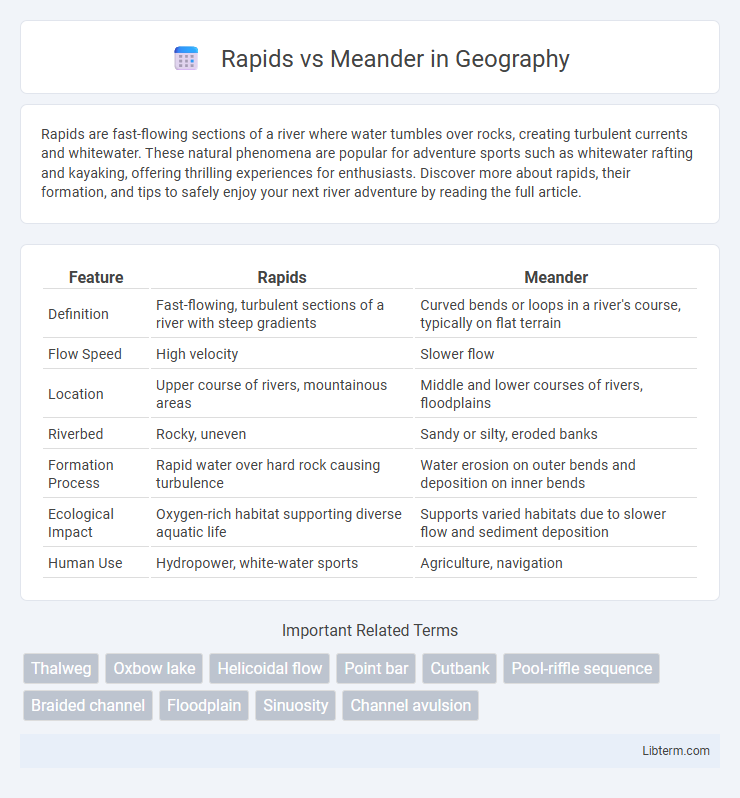Rapids are fast-flowing sections of a river where water tumbles over rocks, creating turbulent currents and whitewater. These natural phenomena are popular for adventure sports such as whitewater rafting and kayaking, offering thrilling experiences for enthusiasts. Discover more about rapids, their formation, and tips to safely enjoy your next river adventure by reading the full article.
Table of Comparison
| Feature | Rapids | Meander |
|---|---|---|
| Definition | Fast-flowing, turbulent sections of a river with steep gradients | Curved bends or loops in a river's course, typically on flat terrain |
| Flow Speed | High velocity | Slower flow |
| Location | Upper course of rivers, mountainous areas | Middle and lower courses of rivers, floodplains |
| Riverbed | Rocky, uneven | Sandy or silty, eroded banks |
| Formation Process | Rapid water over hard rock causing turbulence | Water erosion on outer bends and deposition on inner bends |
| Ecological Impact | Oxygen-rich habitat supporting diverse aquatic life | Supports varied habitats due to slower flow and sediment deposition |
| Human Use | Hydropower, white-water sports | Agriculture, navigation |
Introduction to River Features: Rapids and Meanders
Rapids are sections of a river characterized by turbulent, fast-flowing water over steep gradients and rocky beds, creating whitewater effects essential for aquatic oxygenation and habitat diversity. Meanders, on the other hand, are sinuous river bends formed by lateral erosion and deposition processes, promoting nutrient-rich floodplains and wildlife habitats. Both features play crucial roles in river morphology, influencing sediment transport and ecosystem dynamics.
Defining Rapids: Characteristics and Formation
Rapids are turbulent sections of a river where water flows swiftly over a steep gradient, typically characterized by whitewater caused by rocks and sudden drops. Their formation results from a combination of steep riverbed slope, resistant rock formations, and constricted channels that increase water velocity and turbulence. These dynamic features contrast with calmer river stretches, making rapids important for ecological diversity and recreational activities like whitewater rafting.
Understanding Meanders: Shape and Development
Meanders develop in rivers with gentle slopes where the water flow erodes the outer banks and deposits sediment on the inner banks, creating a sinuous, curving pattern. These bends increase in size and complexity over time, influenced by variables such as water velocity, sediment load, and riverbank composition. The distinctive S-shaped curves of meanders help distribute energy and sediment, contributing significantly to river ecosystem diversity and landscape evolution.
Geological Factors Influencing Rapids and Meanders
Rapids form in rivers where the gradient steepens abruptly, often due to resistant rock outcrops or tectonic uplift causing increased water velocity and turbulence. Meanders develop in flatter, sediment-rich floodplains where lateral erosion and deposition processes dominate, creating sinuous river bends. Variations in bedrock composition, sediment load, and slope gradient are critical geological factors determining the presence of rapids or meanders in a river system.
Hydrodynamic Differences: Speed and Flow Patterns
Rapids exhibit turbulent, fast-moving water with irregular, chaotic flow patterns caused by steep gradients and submerged obstacles, increasing energy and erosion potential. Meanders feature slower, laminar flow with smooth, curving bends in rivers, leading to sediment deposition and channel migration. The contrasting hydrodynamics between rapids and meanders significantly influence river morphology and ecosystem dynamics.
Ecological Impact of Rapids and Meanders
Rapids create highly oxygenated waters that support diverse aquatic species adapted to fast-flowing environments, enhancing biodiversity in river ecosystems. Meanders promote slower water flow and sediment deposition, forming rich floodplains and wetlands that provide critical habitats for various plants, fish, and bird species. Both rapids and meanders contribute uniquely to ecological balance by sustaining different biological communities and influencing nutrient cycling in freshwater systems.
Human Interaction and Recreation in Rapids vs Meanders
Rapids attract thrill-seekers for white-water rafting and kayaking, offering challenging and adrenaline-pumping water activities that depend on fast-flowing, turbulent currents. Meanders provide calmer waters ideal for fishing, canoeing, and scenic boat rides, encouraging leisurely recreation and ecological exploration along winding river bends. Human interaction with rapids often involves safety measures and skill development, while meanders support sustainable tourism and habitat conservation through gentle water access.
Erosion and Sediment Deposition Processes
Rapids occur where fast-moving water flows over steep gradients, causing intense erosion through hydraulic action and abrasion that breaks down rock and sediment. In contrast, meanders form in slower-moving sections of a river with gentle slopes, where erosion primarily happens on the outer bends via lateral erosion, while sediment deposition builds up on inner bends creating point bars. The balance between these erosion and deposition processes shapes river morphology, with rapids characterized by predominant erosion and meanders by alternating zones of erosion and sediment accumulation.
Global Examples of Famous Rapids and Meanders
The Colorado River's Grand Canyon Rapids, including Lava Falls and Crystal Rapid, are among the most famous rapids known for their intense whitewater turbulence. The Amazon River showcases massive meanders such as the bend near Manaus, Brazil, demonstrating significant lateral erosion and sediment deposition. In Africa, the Congo River's rapids, like Boyoma Falls, and the Niger River's distinct meanders exemplify dynamic fluvial processes on a global scale.
Comparing the Environmental Significance of Rapids and Meanders
Rapids create highly oxygenated water, supporting diverse aquatic life and improving ecosystem health, while meanders slow water flow, fostering sediment deposition and nutrient-rich habitats ideal for wetland species. Rapids contribute to erosion and mixing of river substrates, enhancing biodiversity by providing varied microhabitats, whereas meanders promote floodplain connectivity, which recharges groundwater and maintains wetland ecosystems. Both features play crucial roles in river ecology by balancing habitat diversity, nutrient cycling, and water quality regulation essential for environmental sustainability.
Rapids Infographic

 libterm.com
libterm.com